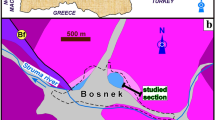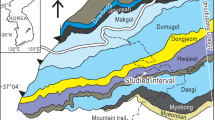Abstract
Lacustrine limestones were formerly identified by their faunistic (limnea, planorbis) and floristic (Charophytes) content. For 30 years, indications of pedogenesis have been found in many lacustrine deposits, and consequently the concept of palustrine limestone was defined.
Lacustrine fabrics are not that numerous: varved, laminated, homogeneous, peloidal, brecciated, gravelly, bioturbated (burrows), bioclastic, algal, and stromatolitic. Detrital beds are sometimes present and are interpreted as bottomset deposits. Palustrine fabrics result from exposure and pedogenesis of lacustrine mud. The main processes involved in this evolution are: cracking, with planar, curved, craze and skew planes, colonization by plants resulting in root traces, marmorization (redistribution of iron due to water table fluctuation), and redistribution of carbonates (needles, subspherical or cylindrical vertical nodules, carbonate coatings, early and late diagenetic crystals, Microcodium). Carbonate palustrine features can be associated with other minerals: palygorskite, gypsum, or silica. Alternation of lacustrine sedimentation and exposure/pedogenesis leads to the pseudo-microkarst facies resulting from enlargement of the complex network of root traces and horizontal cracks. The voids in the pseudo-microkarst facies are infilled with a polyphased internal sediment composed of carbonate and vadose silt and phreatic and vadose cements. Traces of exposure and pedogenesis are less in evidence in lacustrine bioclastic sands and algal-stromatolitic limestones. Finally, under certain conditions, the surficial laminar horizon and its associated perlitic crust (ooids) develops on palustrine muds and form a desert stromatolite.
Similar content being viewed by others
References
Aassoumi, H., J. Broutin, M. El Wartiti, P. Freytet, J.-C. Koeniguer, C. Quesada, F. Simancas & N. Toutin-Morin, 1992. Pedological nodules with cone-in-cone structure in the Permian of Sierra Morena (Spain) and Central Morocco. Carbonates & Evaporites 7: 140–149.
Bates, R. L. & J. A. Jackson, 1980. Glossary of Geology. American Geological Institute, Falls Church, 751 pp.
Black, M., 1933. The algal sediments of Andros Islands, Bahamas. Phil. Trans. Lond. B. 222: 165–192.
Boer, P. L. de, 1981. Mechanical effect of microorganisms in intertidal bedform migration. Sedimentology 28: 129–132.
Bradley, W. H., 1929. Algal reefs and oolithes of the Green River Formation. U.S. Geol. Survey Prof. Paper 154–G: 203–223.
Brewer, R., 1964. In Fabric and Mineral Analysis of Soils. John Wiley, London, 470 pp.
Brunskill, G. T., 1969. Fayetteville Green Lake, New-York. II, Precipitation and sedimentation of calcite in a meromicric lake with laminated sediments. Limnol. Oceanogr. 14: 830–847.
Chafetz, H. S., 1986. Marine peloids: a product of bacterially induced precipitation of calcite. J. Sed. Petrol. 56: 812–817.
De Geer, G., 1912. A geochronology of the last 12,000 years. 11th Intern. Congr. Geol. 1910: 241–253.
Dudgeon, D., 1982. An investigation into some physical and biotic effects of flooding on reservoir mud previously subjected to a period of aerial exposure. Hydrobiologia 97: 27–35.
Eardly, A. J., 1938. Sediments of Great Salt Lake, Utah. Am. Assoc. Petrol. Geol. Bull. 22: 1305–1411.
Eardley, A. J. & V. Gvosdetsky, 1960, Analysis of Pleistocene core from Great Salt Lake, Utah. Bull. Geol. Soc. Am. 71: 1323–1344.
Fahraeus, L. E., R. M. Slatt & G. S. Nowlan, 1974. Origin of carbonate pseudopellets. J. Sed. Petrol. 44: 27–29.
Fayol, H., 1886. Résumé de la théorie des deltas et histoire de la formation du bassin de Commentry. Bull. Soc. Géol. Fr. XVI: 968–978.
Forel, F. A., 1901. Le Léman, monographie limnologique, III. F. Rouge, Lausanne, 715 pp.
Fort, M., D. W. Burbank & P. Freytet, 1989. Lacustrine sedimentation in a semi-arid alpine setting: an example from Ladakh, Northwestern Himalayas. Quat. Res. 31: 332–350.
Freytet, P., 1964. Le Vitrollien des Corbières orientales: réflexions sur la sédimentation 'lacustre' nord-pyrénéenne; divgation fluviatile, biorhexistasie, pédogénèse. Rev. Géogr. Phys. Géol. Dyn. VI: 179–199.
Freytet, P., 1971. Paléosols résiduels et paléosols alluviaux hydromorphes dans le Crétacé supérieur et l'Eocène basal en Languedoc. Rev. Géogr. Phys. Géol. Dyn. XIII: 245–268.
Freytet, P., 1973. Petrography and paleoenvironments of continental carbonated deposits with a particular reference to Upper Cretaceous and Lower Eocene of Languedoc, Southern France. Sed. Geol. 10: 25–60.
Freytet, P., 1984. Les sédiments lacustres carbonatés et leur transformation par émersion et pédogénèse. Importance de leur identification pour les reconstitutions paléogéographiques. Bull. Centre Rech. Explor.-Produc. Elf Aquitaine 8: 223–247.
Freytet, P., 1997. Non-marine, Permian to Holocene algae from France and adjacent countries I. Ann. Paleontol. 83: 289–332.
Freytet, P., 1998. Non-marine, Permian to Holocene algae from France and adjacent countries II. Ann. Paleontol. 84: 3–51.
Freytet, P., 2000. Distribution and paleoecology of non marine algae and stromatolites: II, the Limagne of Allier, Oligo-Miocene lake (Central France). Ann. Paleontol. 86: 3–57.
Freytet, P. & J.-C. Plaziat, 1982. Continental carbonate sedimentation and pedogenesis-Late Cretaceous and Early Tertiary of Southern France. In Purser, B. H. (ed.), Contrib. Sedimentology, Schweizerbart'sche Verlag, Stuttgart, 12, 217 pp.
Freytet, P. & E. P. Verrecchia, 1998. Freshwater organisms that build stromatolites: a synopsis of biocrystallization by prokaryotic and eukaryotic algae. Sedimentology 45: 535–563.
Freytet, P., F. Baltzer, O. Conchon., J.-C. Plaziat & B. H. Purser, 1994. Signification hydrologique et climatique des carbonates continentaux quaternaires de la bordure du désert oriental égyptien (côte de la mer Rouge). Bull. Soc. Géol. Fr. 165: 593–601.
Freytet P., N. Toutin-Morin, J. Broutin, P. Debriette, M. Durand, M. El Wartiti, G. Gand, H. Kerp, F. Orszag, Y. Paquette, O. Ronchi & J. Sarfati, 1999. Paleoecology of non-marine algae and stromatolites-Permian of France and adjacent countries. Ann. Paleont. 85: 99–153.
Gilbert, G. K., 1885. The topographic features of lake shores. Ann. Rep. U.S. Geol. Survey 5: 69–123.
Hawley, N. & C. H. Lee, 1999. Sediment resuspension and transport in Lake Michigan during stratified period. Sedimentology 46: 791–805.
Johnson, J. H., 1937. Algae and algal limestone from the Oligocene of South Park, Colorado. Bull. Geol. Soc. Am. 48: 1227–1235.
Kahle, C. F., 1977. Origin of subaerial Holocene calcareous crusts: role of algae, fungi, and sparmicritization. Sedimentology 42: 413–435.
Kalkowsky, E., 1908. Oolith und Stromatolith im norddeutschen Bundsandstein, Z. Deutsche geologische Gesellschaft, Berlin, 60: 68–125.
Kelts, K. & K. J. Hsü, 1978. Freshwater carbonate sedimentation. In Lerman, A. (ed.), Lakes, Chemistry, Geology, Physics. Springer, Berlin, 295–323.
Klappa, C. F., 1980, Rhizoliths in terrestrial carbonates: classification, recognition, genesis and significance. Sedimentology 27: 613–629.
Mac Issac, H. T. & P. Rocha, 1995. Effects of suspended clay on Zebra mussel (Dreisena polymorpha) foeces and pseudofoeces production. Arch. Hydrobiol. 135: 53–64.
Morrison, R. B., 1964. Lake Lahontan: geology of the southern Carson Desert, Nevada. U.S. Geol. Survey Prof. Paper 401, 165 pp.
Neumann, A. G., C. D. Gebelin & T. P. Scoffin, 1970. The composition, structure and erodability of subtidal mats, Abaco, Bahamas. J. Sed. Petrol. 40: 274–297.
Platt, N. H. & V. P. Wright, 1992. Lacustrine carbonates: facies models, facies distribution and hydrocarbon aspects. In Anadon, P., L. Cabrera & K. Kelts (eds), Lacustrine Facies Analysis. IAS spec. publ. 13. Blackwell, Oxford, 57–74.
Plaziat, J. C. & P. Freytet, 1978. Le pseudomicrokarst pédologique: un aspect particulier des paléopédogénèses développées sur les dépôts calcaires lacustres dans le Tertiaire du Languedoc. C. r. Acad. Sci. Paris D 286: 1661–1664.
Sturm, M. & A. Matter, 1978. Turbidites and varves in Lake Brienz (Switzerland): deposition of calstic detritus by density currents. In Matter, A. & M. E. Tucker (eds), Modern and Ancient Lake Sediments. IAS. spec. publ. 2. Blackwell, Oxford, 147–168.
Tevesz, M. J. S, F. M. Soster & P. L. McCall, 1981. The effects of size selective feeding by Oligochaetes on the physical properties of river sediment. J. Sed. Petrol. 50: 561–568.
Thompson, J. B., F. G. Ferris & T. H. D. Smith, 1990. Geomicrobiology and sedimentology of the mixolimnion and chemocline in Fayetteville Green lake, New York. Palaios 5: 52–75.
Verrecchia, E. & P. Freytet, 1987. Interférence pédogénèse sédimentation dans les croûtes calcaires-Proposition d'une nouvelle méthode d'étude: l'analyse séquentielle. In Fédoroff, N. (ed.), Soil Micromorphology. AFES, Paris, 555–561.
Verrecchia, E. P., 1994. L'origine biologique et superficielle des croûtes zonaires. Bull. Soc. Géol. Fr. 165: 583–592.
Verrecchia, E. P. & K. Verrecchia, 1994. Needle-fiber calcite: critical review and proposed classification. J. Sed. Res. A64: 650–664.
Verrecchia, E. P., P. Freytet, K. Verrecchia & J.-L. Dumont, 1995. Spherulites in calcrete laminar crust: biogenic CaCO3 precipitation as a major contributor to crust formation. J. Sed. Res. A65: 690–700.
Verrecchia, E. P., P. Freytet, K. Verrecchia & J.-L Dumont, 1996. Spherulites in calcrete laminar crust: biogenic CaCO3 precipitation as a major contributor to crust formation-Reply. J. Sed. Res. A66: 1041–1044.
Winsborough, B. M. & S. Golubic, 1987. The role of diatoms in stromatolite growth: two examples from modern freshwater settings. J. Phycol. 23: 195–201.
Author information
Authors and Affiliations
Rights and permissions
About this article
Cite this article
Freytet, P., Verrecchia, E.P. Lacustrine and palustrine carbonate petrography: an overview. Journal of Paleolimnology 27, 221–237 (2002). https://doi.org/10.1023/A:1014263722766
Issue Date:
DOI: https://doi.org/10.1023/A:1014263722766




